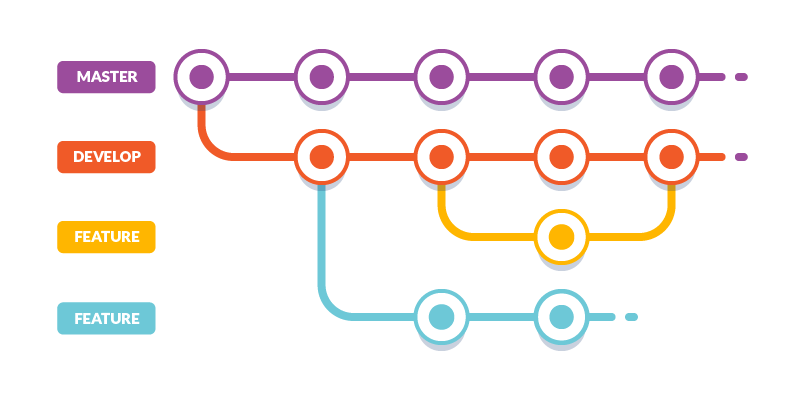
0.- Overview #
GitFlow is a branching model for Git, designed by Vincent Driessen, that defines a clear structure for managing feature development and releases in a more organized way. It’s particularly popular in large projects and teams because it helps manage complexity and promotes parallel development. Here’s an introduction to GitFlow:
0.1.- Benefits of GitFlow #
- Clear Structure: GitFlow provides a well-organized way to manage feature development, releases, and hotfixes.
- Parallel Development: Multiple features can be developed simultaneously without interfering with each other.
- Isolated Releases: Release branches allow teams to prepare releases without disrupting ongoing development work.
- Safe Hotfixes: Hotfixes can be applied quickly without disrupting other branches.
0.2.- Drawbacks of GitFlow #
- Complexity: GitFlow introduces several branches and processes, which can be complex for smaller teams or projects.
- Overhead: The model adds overhead in managing multiple branches, especially if the team or project size doesn’t justify it.
1.- Basic Gitflow #
GitFlow is a workflow that builds on the basic principles of Git, introducing well-defined branch structures and practices for working with them. It organizes work into different branches, each serving a specific purpose in the development cycle.
1.1.- Key Concepts and Branches in GitFlow #
GitFlow defines several types of branches, each with a distinct role:
main Branch:
- This branch holds the production-ready code.
- The
mainbranch should always reflect the state of the latest release. - Direct commits to
mainare avoided; instead, changes are merged from other branches.
develop Branch:
- This is the integration branch for features and the source for releases.
- All new features and updates are merged into
develop. - Once a feature is complete, it’s merged into
develop, where it’s tested and prepared for a future release.
Feature Branches:
- Created from:
develop - Merged into:
develop - Naming convention:
feature/feature-name - Feature branches are used to develop new features or enhancements.
- These branches are short-lived and are deleted after they are merged into
develop.
1.2.- Gitflow iteration example #
Using a calculator app as an example, we will go through all the stages of gitflow, asuming two people are contributing to the same project at the same time.

- Repository creation: We create the project and upload it to our git hosting of choice. As the repository gets initialised, a first branch “main” and an initial comit gets created.
- Development Start: We create from the “main” branch the “develop” branch. In here we won’t make any code/content changes. The “develop” branch works as a spinal column for the project.
- Calculator Output: We create our first feature branch “feature/IO“. In here we will do only the development related to the feature. In this case, the first comit is of the output of the calculator
- Calculator Input: To finish the feature IO, we do another comit containing the input code for our calculcator
- Feature/IO finished: Once a feature gets finished, we merge it to the “develop” branch. Notice that we haven’t touched the “develop” branch with any comits. We do content changes & comits on feature branches, and when finished we incorporate them into the “develop” branch
- Integer multiplication: Now the development team splits development and parallelize work. “Person A” creates a new branch “feature/Mult” and makes a comit with the code for multiplication with integers.
- Integer division: “Person B” creates a new branch “feature/Div” and makes a comit with the code for division with integers.
- Decimal division: “Person B” continues on branch “feature/Div” and makes a comit with the code for division with decimals.
- Feature/Div finished: “Person B” finishes the work on branch “feature/Div” and merges it to “develop“.
- Merge from develop: “Person A” notices new work on the “develop” branch and merges it to the “feature/Mult” branch to have the lastest changes.
- Decimal multiplication: “Person A” continues on branch “feature/Mult” and makes a comit with the code for multiplication with decimals.
- Feature/Mult finished: “Person A” finishes the work on branch “feature/Mult” and merges it to “develop“.
- v 1.0: The team has finished the first development cycle, builds the app, and creates a release version on the “main” branch. Notice how in the “main” branch we did no development work or any merges. In this branch only must go completely finished & tested work coming from “develop“.
2.- Advanced Gitflow #
When using gitflow on bigger teams or on public repositories, it’s recomended to use more types of branches and a few common tools.
2.1.- Advanced branches in Gitflow #
Release Branches:
- Created from:
develop - Merged into:
mainanddevelop - Naming convention:
release/release-name(e.g.,release/v1.0) - When
developreaches a stable state and a new version is ready, a release branch is created. - This branch is used for final bug fixes and preparing for the release (e.g., updating version numbers, documentation).
- Once everything is finalized, the release branch is merged into both
mainanddevelop.
Hotfix Branches:
- Created from:
main - Merged into:
mainanddevelop - Naming convention:
hotfix/hotfix-name - Hotfix branches are used to quickly address critical issues in the production code.
- After the fix is implemented, the branch is merged into both
mainanddevelopto ensure the fix is included in future releases.
2.2.- Merge/Pull request #
- Allows merging into protected branches
- Prevents from merging conflicts
- Needs to be approved by a team member
- Merges are done only by an administrator
2.3.- Releases & Tags #
Releases are complete versions of a repository, compiled and ready for production use. They usually contain:
- The compiled project
- Any necessary libraries
- A copy of the source code
- Changelog since the last release
Tags are a “generic” version of a release. Usually a tag is the production version number (1.0, 1.1, 1.2)